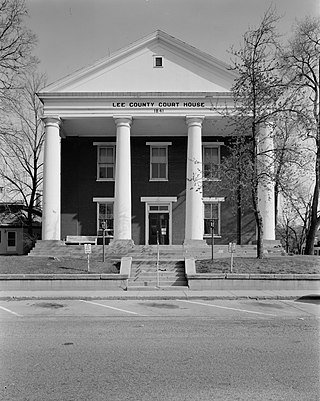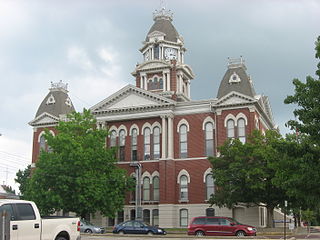
The Vandalia State House, built in 1836, is the fourth capitol building of the U.S. state of Illinois. It is also the oldest capitol building in Illinois to survive, as the first, second, and third capitol buildings have all disappeared. The brick Federal style state house has been operated by the state of Illinois as a monument of Illinois' pioneer years since 1933. It is located in Vandalia, Illinois, on the National Road, and listed on the National Register of Historic Places.
The McLean County Courthouse and Square is located in downtown Bloomington, Illinois. The site is on the National Register of Historic Places and encompasses the old McLean County Courthouse and the courthouse-facing sides of three downtown blocks. All 4 floors of the building are now occupied by the McLean County Museum of History for exhibits, collections storage, and offices. The historic buildings at the other side of the square were destroyed by fire in the 1980s. The Square is bordered by four Bloomington streets: Main Street, Center Street, Jefferson Street and Washington Street. The site was home to three previous courthouses before the current one was completed in 1903. The first courthouse at the site was built in 1831, and the second in 1836. The third was built in 1868, but suffered major damage from fire on June 19, 1900.

The Ogle County Courthouse is a National Register of Historic Places listing in the Ogle County, Illinois, county seat of Oregon. The building stands on a public square in the city's downtown commercial district. The current structure was completed in 1891 and was preceded by two other buildings, one of which was destroyed by a group of outlaws. Following the destruction of the courthouse, the county was without a judicial building for a period during the 1840s. The Ogle County Courthouse was designed by Chicago architect George O. Garnsey in the Romanesque Revival style of architecture. The ridged roof is dominated by its wooden cupola which stands out at a distance.

The Hawkins County Courthouse is the seat of county government for Hawkins County, Tennessee, United States, located in the city of Rogersville. It was built in 1836, it is one of six antebellum courthouses still in use in Tennessee, and it is the second oldest courthouse still in use in the state.

The Huron County Courthouse and Jail is located by a busy downtown intersection in Norwalk, Ohio, United States. The ground floor is composed of rusticated blocks and recessed arched windows. The entrance is reached by a flight of stairs and a protruding portico. Two small windows frame either side of the entrance.

The Geauga County Courthouse is located at 100 Short Court Street in Chardon, Ohio. The cornerstone was laid September 10, 1869 and construction was completed on August 20, 1870. The courthouse was listed on the National Register in 1974 as part of the Chardon Courthouse Square District.

The Courthouse of Crawford County, Ohio, is a landmark of the county seat, Bucyrus, Ohio. The courthouse was built in 1854 on East Mansfield Street by architect Harlan Jones and was added to the National Register of Historic Places on 1985-02-28 as a part of the Bucyrus Commercial Historic District.

The Mineral County Courthouse, also known as the 1883 Esmeralda County Courthouse and the Old Mineral County Courthouse, is an historic county courthouse building located at 551 C Street in Hawthorne, Mineral County, Nevada. Built in 1883 as the Esmeralda County Courthouse, it served as such until 1907 when the county seat was moved to Goldfield. In 1911 when Mineral County was created, it became the first Mineral County Courthouse, and served until 1970, when a new courthouse was constructed. It is the only building in Nevada to have served as the courthouse of two different counties. On January 29, 1982 it was listed on the National Register of Historic Places. As of 2008 (photo), it was fenced off and in disrepair.

The Kingman County Courthouse, located at 130 Spruce Street in Kingman, Kansas, is an historic 3-story redbrick courthouse building set on a ground-floor basement of rough-faced white limestone. The stairway and entrance portico leading to the main entrance are of the same limestone. Its roof is basically hipped with gables in the middle of each side, pyramids on each corner and an octagonal shaped cupola rising from the center. Built in 1907-08 for Kingman County, it is one of 15 courthouses designed by architect George P. Washburn of Ottawa, Kansas. His design for this building has been called a mixture of Late Victorian, Romanesque, Free Classical and Queen Anne architectural styles.
The Clinton County Courthouse is located at 53 East Main Street in Wilmington, Ohio. The courthouse is included in the Wilmington Commercial Historic District which was added to the National Register on 1982-10-14.

The Marshall County Courthouse is located in Marshalltown, Iowa, United States. The current building was completed in 1886 to replace an earlier building. The courthouse is a dominant landmark in downtown Marshalltown. It was individually listed on the National Register of Historic Places in 1972. In 2002 it was listed as a contributing property in the Marshalltown Downtown Historic District. It is the third building the county has used for a courthouse and county business.

The Madison County Courthouse is located in Winterset, Iowa, United States. It was listed on the National Register of Historic Places in 1981 as a part of the County Courthouses in Iowa Thematic Resource. It was included as a contributing property in the Winterset Courthouse Square Commercial Historic District in 2015. The courthouse is the third building the county has used for court functions and county administration.

The Lee County Courthouse is located in Fort Madison, Iowa, United States. The courthouse serves the court functions and county administration for the northern part of Lee County, and it is the county's first courthouse. It was listed on the National Register of Historic Places in 1976 as a part of the County Courthouses in Iowa Thematic Resource. In 2014, it was included as a contributing property in the Park-to-Park Residential Historic District. Southern Lee County is served from a courthouse in Keokuk in the former Federal Courthouse building.

The Osceola County Courthouse in Sibley, Iowa, United States, was built in 1902. It was listed on the National Register of Historic Places in 1981 as a part of the County Courthouses in Iowa Thematic Resource. The courthouse is the second building the county has used for court functions and county administration.

The Benton County Courthouse, located in Vinton, Iowa, United States, was built in 1906. It was listed on the National Register of Historic Places in 1976 as a part of the County Courthouses in Iowa Thematic Resource. The courthouse is the fourth building the county has used for court functions and county administration.

The Paw Paw City Hall is a government building located at 111 East Michigan Avenue in Paw Paw, Michigan. It was designated a Michigan State Historic Site in 1971 and listed on the National Register of Historic Places in 1972.

The Mount Sterling Commercial Historic District is a historic business district located in downtown Mount Sterling, Illinois. The district, located immediately south of the Brown County Courthouse, includes four entire city blocks and parts of four others; 38 buildings, of which 35 are contributing buildings, are in the district.

The Ionia County Courthouse is a government building located on East Main Street in Ionia, Michigan. It was listed on the National Register of Historic Places in 1979.

The Henderson County Courthouse is a government building in Oquawka, the county seat of Henderson County, Illinois, United States. Built in 1842 and later expanded, it remains in use as the county's courthouse, despite repeated attempts by other towns to obtain the status of county seat.

The Shelby County Courthouse is a government building in Shelbyville, the county seat of Shelby County, Illinois, United States. Completed in 1881, it is the third courthouse in the county's history.




















